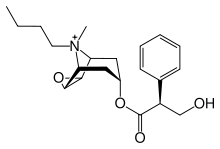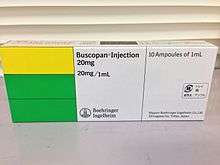Hyoscine butylbromide
Hyoscine butylbromide, also known as scopolamine butylbromide[2] and sold under the brandname Buscopan among others,[3] is a medication used to treat crampy abdominal pain, esophageal spasms, renal colic, and bladder spasms.[4][5] It is also used to improve respiratory secretions at the end of life.[6] Hyoscine butylbromide can be taken by mouth, injection into a muscle, or into a vein.[3]
 | |
| Clinical data | |
|---|---|
| Trade names | Buscopan, others |
| Other names | Butylscopolamine bromide, scopolamine butylbromide |
| License data | |
| Routes of administration | By mouth, rectal, intravenous |
| ATC code | |
| Legal status | |
| Legal status |
|
| Pharmacokinetic data | |
| Bioavailability | <1% |
| Protein binding | Low |
| Elimination half-life | 5 hours |
| Excretion | Renal (50%) and fecal[1] |
| Identifiers | |
| |
| CAS Number | |
| PubChem CID | |
| DrugBank | |
| ChemSpider | |
| UNII | |
| KEGG | |
| ChEBI | |
| ChEMBL | |
| CompTox Dashboard (EPA) | |
| ECHA InfoCard | 100.005.223 |
| Chemical and physical data | |
| Formula | C21H30BrNO4+ |
| Molar mass | 440.378 g·mol−1 |
| 3D model (JSmol) | |
| |
| |
| | |
Side effects may include sleepiness, vision changes, dry mouth, rapid heart rate, triggering of glaucoma, and severe allergies.[4] Sleepiness is uncommon.[7] It is unclear if it is safe in pregnancy.[3] It appears safe in breastfeeding.[8] Greater care is recommended in those with heart problems.[9] It is an anticholinergic agent,[3] which does not have much effect on the brain.[10]
Hyoscine butylbromide was patented in 1950, and approved for medical use in 1951.[11] It is on the World Health Organization's List of Essential Medicines.[12] It is not available in the United States,[13] and a similar compound methscopolamine may be used instead.[14] It is manufactured from hyoscine, which occurs naturally in the plant deadly nightshade.[15]
Medical uses

Hyoscine butylbromide is effective in treating crampy abdominal pain.[16]
Hyoscine butylbromide is effective in reducing the duration of the first stage of labour, and it is not associated with any obvious adverse outcomes in mother or neonate.[17]
It is also used during abdominal or pelvic MRI or CT scans to improve the quality of pictures.[18]
Side effects
As little of the medication crosses the blood brain barrier it has less effect on the brain and therefore has reduced occurrence of the centrally mediated effects (such as delusions, somnolence, and inhibition of motor-functions) which hinder the usefulness of some other anticholinergic drugs.[10] Hyoscine butylbromide is still capable of impacting the chemoreceptor trigger zone due to the lack of a well-developed blood-brain-barrier in the medulla oblongata, which potentiates the antiemetic effects that it produces via local action on the smooth muscle of the gastrointestinal tract.[19]
Pharmacology
Hyoscine butylbromide reduces the stimulation of smooth muscle contraction and the production of respiratory secretions. These are normally stimulated by the parasympathetic nervous system, via the neurotransmitter acetylcholine. As an antimuscarinic, hyoscine butylbromide binds to muscarinic acetylcholine receptors, blocking their effect.[20]
It is a quaternary ammonium compound and a semisynthetic derivative of hyoscine hydrobromide (scopolamine). The attachment of the butyl-bromide moiety effectively prevents the movement of this drug across the blood–brain barrier, effectively minimising undesirable central nervous system side effects associated with scopolamine/hyoscine.[20]
Abuse
Hyoscine butylbromide is not centrally active and has a low incidence of abuse. In 2015, it was reported that prisoners at Wandsworth Prison and other UK prisons were smoking prescribed hyoscine butylbromide, releasing the potent hallucinogen scopolamine.[21][22] There have also been reports of abuse in Mashhad Central Prison in Iran.[23]
References
- Tytgat, Guido N (2007). "Hyoscine Butylbromide". Drugs. Springer Science and Business Media LLC. 67 (9): 1343–1357. doi:10.2165/00003495-200767090-00007. ISSN 0012-6667.
- Juo P (2001). Concise Dictionary of Biomedicine and Molecular Biology (2nd ed.). Hoboken: CRC Press. p. 570. ISBN 9781420041309. Archived from the original on 2015-12-08.
- "Buscopan Tablets and Ampoules". Therapeutic Goods Administration, Australia. 8 November 2010. Archived from the original on 30 March 2017. Retrieved 22 October 2013. Cite journal requires
|journal=(help) - "Hyoscine butylbromide SXP". www.ebs.tga.gov.au. 3 July 2017. Retrieved 15 March 2018.
- Hamilton R (2015). Tarascon Pocket Pharmacopoeia 2015 Deluxe Lab-Coat Edition. Jones & Bartlett Learning. p. 270. ISBN 9781284057560.
- Paice J (2015). Care of the Imminently Dying. Oxford University Press. p. 43. ISBN 9780190244309. Archived from the original on 2015-12-08.
- Handbook of Palliative Care (3rd ed.). New York: Wiley. 2012. p. 570. ISBN 9781118426814. Archived from the original on 2015-12-08.
- "Hyoscine" (PDF). www.kemh.health.wa.gov.au. Retrieved 11 September 2019.
- "Hyoscine butylbromide (Buscopan) injection: risk of serious adverse effects in patients with underlying cardiac disease". www.gov.uk. 20 February 2017. Retrieved 15 March 2018.
hyoscine butylbromide injection should be used with caution in patients with cardiac disease
- Hanks G (2011). Oxford textbook of palliative medicine (4th ed.). Oxford [etc.]: Oxford University Press. p. 805. ISBN 9780199693146. Archived from the original on 2015-12-08.
- Fischer J, Ganellin CR (2006). Analogue-based Drug Discovery. John Wiley & Sons. p. 446. ISBN 9783527607495.
- World Health Organization (2019). World Health Organization model list of essential medicines: 21st list 2019. Geneva: World Health Organization. hdl:10665/325771. WHO/MVP/EMP/IAU/2019.06. License: CC BY-NC-SA 3.0 IGO.
- Prommer EE, Thompson L, Casciato DA (2012). "Supportive Care". In Casciato DA, Territo MC (eds.). Manual of Clinical Oncology (7th ed.). Philadelphia: Wolters Kluwer/Lippincott Williams & Wilkins Health. p. 146. ISBN 9781451115604. Archived from the original on 2015-12-08.
- Satoskar RS, Rege SD, Bhandarkar NN (1973). Pharmacology and Pharmacotherapeutics. Popular Prakashan. p. 296. ISBN 9788179915271.
- Twycross R (2003). Introducing palliative care (4th ed.). Oxford: Radcliffe Medical Press. p. 172. ISBN 9781857759150. Archived from the original on 2015-12-08.
- Tytgat GN (2007). "Hyoscine butylbromide: a review of its use in the treatment of abdominal cramping and pain". Drugs. 67 (9): 1343–57. doi:10.2165/00003495-200767090-00007. PMID 17547475.
- Samuels LA, Christie L, Roberts-Gittens B, Fletcher H, Frederick J (December 2007). "The effect of hyoscine butylbromide on the first stage of labour in term pregnancies". BJOG. 114 (12): 1542–6. doi:10.1111/j.1471-0528.2007.01497.x. PMID 17903230.
- "Hyoscine butylbromide (Buscopan®)" (PDF). UK: Guy's and St Thomas' NHS Foundation Trust. July 2014. Archived (PDF) from the original on 8 August 2016. Retrieved 16 June 2016.
- Glare P, Miller J, Nikolova T, Tickoo R (12 September 2011). "Treating nausea and vomiting in palliative care: a review". Clinical Interventions in Aging. 6: 243–59. doi:10.2147/CIA.S13109. PMC 3180521. PMID 21966219.
- "Buscopan 10 mg Tablets - Summary of Product Characteristics (SmPC) - (emc)". www.medicines.org.uk. Retrieved 2020-07-22.
- "Medics warned to review Buscopan prescriptions after prisoners found smoking it". Pulse Today. Retrieved 2018-02-07.
- Optimisation, NECS Medicines (2015-07-21). "Misuse of hyoscine butylbromide (Buscopan) |". medicines.necsu.nhs.uk. Retrieved 2018-02-07.
- Jalali F, Afshari R, Babaei A (June 2014). "Smoking crushed hyoscine/scopolamine tablets as drug abuse". Substance Use & Misuse. 49 (7): 793–7. doi:10.3109/10826084.2014.880178. PMID 24494624.